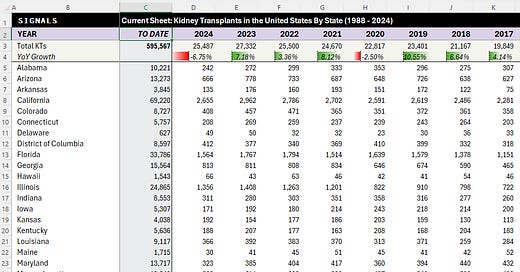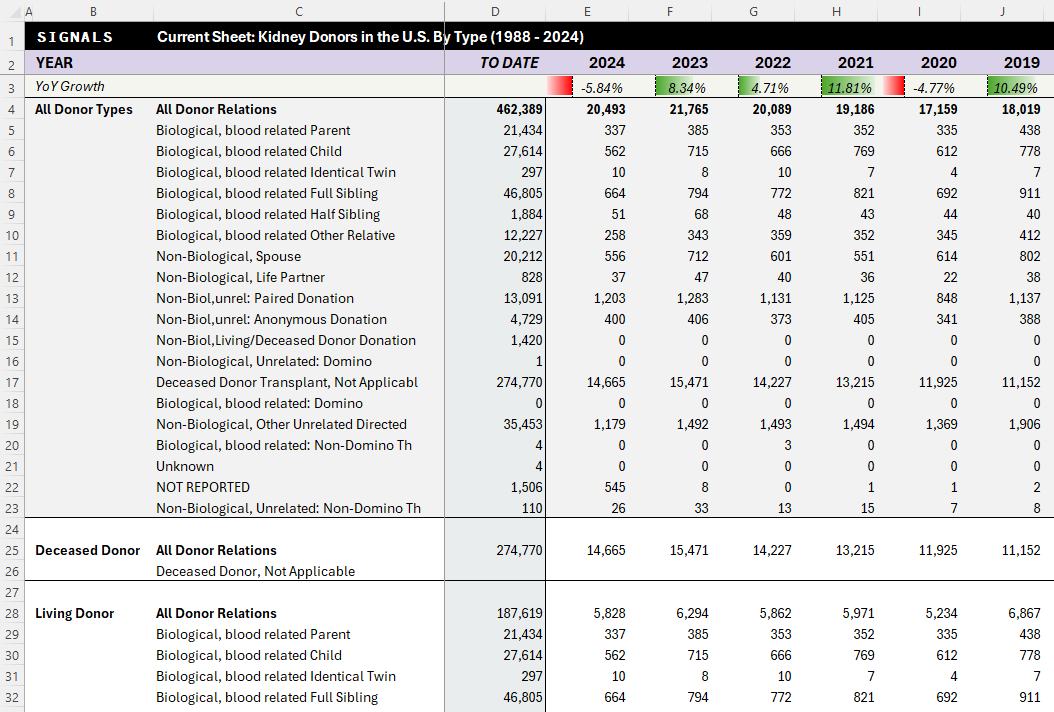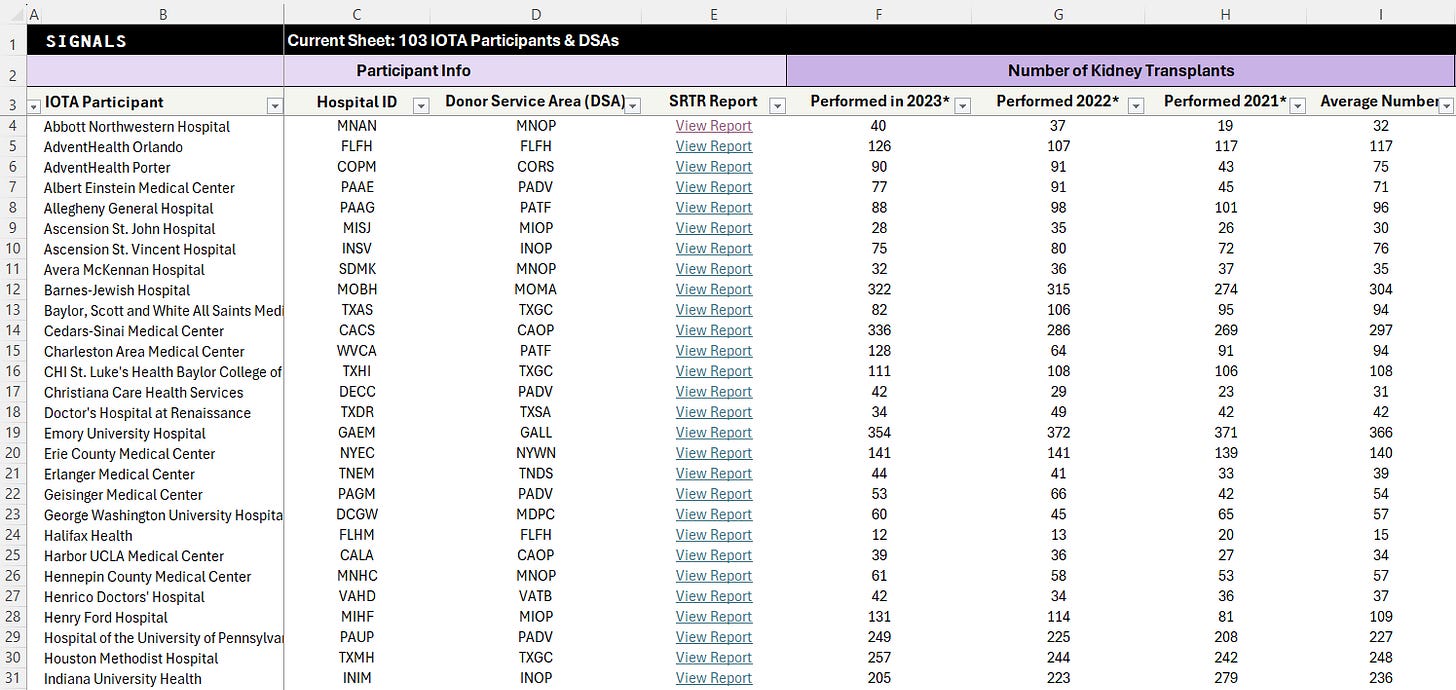Introducing: Transplant Databases
Something "new" I've been working on that will make your lives easier (and mine, too!)
I have some exciting news to share. Over the past 18 months, you’ve seen me use visuals, tables, and extensive linking in my writing—whether it’s to track ESRD trends over time, compare investments, or attempt to simplify complex systems like dialysis or transplant. What you might not know is that behind each of these, I’ve been using data that I organized for myself. As most of you know kidney disease is complex, but finding and understanding data across dozens of sources to support my writing can be a massive challenge. That’s why I started building my own spreadsheets in a way that makes the data easier for me to digest and transform into the content I share with you.
By popular demand and repeated request, I’ve decided to make these databases available to all you in our data room. Whether you're a regular reader in the kidney space, or a casual clicker stumbling onto one of my 45-minute deep dives, there’s something here for you. These resources are designed to help you stay informed, save time, and make smarter decisions.
What’s Included:
Kidney Transplant Trends (1988–2024): This sheet tracks kidney transplants in the United States from 1988 to the present, breaking down data by year and state. It includes total kidney transplants per year, yearly growth percentages, and highlights of the largest and smallest growth years. Key fields include: Year, State, Total Kidney Transplants (KT), Year-over-Year Growth, Key Insights (Largest and Smallest Growth Year), and Top State Contributor (by transplant number). Additionally, the sheet provides the average annual transplants over the last 5, 10, and 15 years, as well as the historical all-time average of kidney transplants.
Kidney Donors by Type (1988–2024): This sheet includes data on kidney donors by type, spanning from 1988 to 2024. Fields include: year-by-year breakdowns, all donor relations, biological and non-biological categories (parent, child, sibling, spouse, etc.), and deceased donor information, as well as growth rates and average annual donations. Key insights include the largest and smallest growth years, top donor types, and comparisons of living versus deceased donations and donor breakdowns by type.
IOTA Participants: This sheet includes detailed data on 103 transplant programs participating in the IOTA model, along with their associated Donor Service Areas (DSAs). It provides an overview of kidney transplant activity across these centers, including the number of transplants performed in 2023, 2022, and 2021. Key insights are included to highlight trends in transplant volume, such as the highest performing programs, the most frequent donor service areas, and the range of transplants performed annually. Fields include: IOTA Participant Name, Hospital ID, DSA, SRTR Report Links, Number of Kidney Transplants Performed (2023, 2022, 2021), Average Number of Transplants, Key Insights, and Transplant Hospital Contact Info.
Key Insights: Along with each sheet, we’ve also provided at-a-glance summaries of critical trends and findings. Some of these are based on common queries I’ve made, or questions I’ve been asked after a piece went out. To the left of each summary you’ll find helpful links to resources worth exploring or having up as your trust co-pilots. This should save you some time, it certainly has for me.
Last thing, many of you have requested the KCC PY22 Results: Tim’s Version. This one and a whole LOT more like it will be part of my upcoming VBC (Value-Based Care) Database that I plan to release next month. This sheet will give you a detailed breakdown of the first-year results of the Kidney Care Choices (KCC) model, including metrics on outcomes, cost per beneficiary, quality, payments, and more. I will release both individual spreadsheets and thematic databases (like this one) as they’re ready.
Access Details:
Paid subscribers can access individual sheets as part of their plan. If you’re already signed up, simply send me a message here or on LinkedIn, and I’ll send over the sheet you need. I’ll be revamping the data room so it’s easier to get what you need when you need it— stay tuned.
Signals Pro is our newest tier, designed for companies, researchers, and industry pros to get access to all databases, content, and the Signals network. More on that later, but please do reach out if you’re interested. Subscriptions per seat.
That’s all for now. Thank you all for your continued support. I’m thrilled to bring these valuable resources to you, and for your feedback that allows me to know this is the type of value that helps you most. I hope they help you dive deeper into the data that’s shaping the future of kidney care.
Feel free to reach out with any questions or feedback, and as always, stay tuned for more insights!
Keep exploring,
Tim
![Signals From [Space]](https://substackcdn.com/image/fetch/w_80,h_80,c_fill,f_auto,q_auto:good,fl_progressive:steep,g_auto/https%3A%2F%2Fsubstack-post-media.s3.amazonaws.com%2Fpublic%2Fimages%2F55686857-6b99-45a6-ac0f-09c9f023f2a0_500x500.png)
![Signals From [Space]](https://substackcdn.com/image/fetch/e_trim:10:white/e_trim:10:transparent/h_72,c_limit,f_auto,q_auto:good,fl_progressive:steep/https%3A%2F%2Fsubstack-post-media.s3.amazonaws.com%2Fpublic%2Fimages%2F4d588ac1-7fac-4bd4-829d-fc7b4e8f1326_1512x288.png)

![Signals From [Space]](https://substackcdn.com/image/fetch/w_36,h_36,c_fill,f_auto,q_auto:good,fl_progressive:steep,g_auto/https%3A%2F%2Fsubstack-post-media.s3.amazonaws.com%2Fpublic%2Fimages%2F55686857-6b99-45a6-ac0f-09c9f023f2a0_500x500.png)





I'm excited for the VBC database! Great work